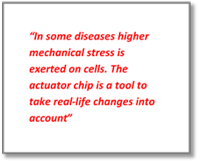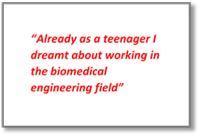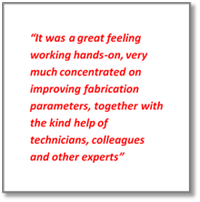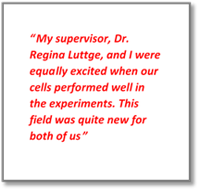 In this thesis artificial scaffolds were designed, fabricated and characterized. The aim was to study neuronal networks in vitro, realizing in vivo comparable extracellular environments.
In this thesis artificial scaffolds were designed, fabricated and characterized. The aim was to study neuronal networks in vitro, realizing in vivo comparable extracellular environments.
‘We have built technological platforms to help study brain diseases medically,’ says Sijia Xie. ‘With the help of nano-fabrication techniques we produced platforms to guide cells; to organize and interact more like in real brains. This might facilitate future medical research in various ways: making it more versatile, less expensive and - in the longer term future - more animal friendly, as less rats will be needed for research ends.’
The PhD work focused on the fabrication of artificial extracellular matrix (ECM) scaffolds, with submicrometer scale linear patterns, realized by micro/nanofabrication techniques. Subsequently the influence of these scaffolds on the formation of primary neuronal networks of the cortex in a rat’s brain was studied.
‘It was demonstrated the scaffolds provide topographical guidance for the orientation of the cell outgrowths,’ Sijia says. ‘This resulted in highly organized neuronal cell networks.’

Also studied in this work was a microfluidic actuator chip, able to exert nanoscale mechanical stimuli on cells cultured atop. ‘By doing so it is possible to simulate how cells sense and react when external changes occur,’ Sijia says. ‘For example, in some diseases higher mechanical stress is exerted on cells because of higher blood pressure. The actuator chip is a tool to take this kind of real-life changes into account.’
The results of her PhD work are useful for further research on engineering a brain-on-a-chip, Sijia concludes. The aim is to establish a well-engineered cell culture and analysis platform, for novel brain disease models, and the better understanding of cellular processes involved in the functions of the brain.
New fields

‘Already as a teenager I dreamt about working in the biomedical engineering field,’ Sijia says. Mesa+ provided her new resources and tools, and helped to add new skills, even new fields of expertise.
Sijia: ‘Originally a chemist, here at Mesa+ I learned nanofabrication techniques, almost from scratch. During my master’s research I already got to know these techniques, but only by drawing and designing, leaving the actual fabrication to experts. Here I had the chance to do it by myself, which is very cool. It was  a great feeling working hands-on, very much concentrated on improving fabrication parameters, together with the kind help oftechnicians, colleagues and other experts. To actually see the output achievements was very encouraging. I have experienced this PhD as an exciting and inspirational detour in the biomedical field.’
a great feeling working hands-on, very much concentrated on improving fabrication parameters, together with the kind help oftechnicians, colleagues and other experts. To actually see the output achievements was very encouraging. I have experienced this PhD as an exciting and inspirational detour in the biomedical field.’
Topnotch
Sijia was able to work in the Cleanroom/Nanolab using fabrication and characterization equipment, and working in the BioNanolab as well. ‘I was very lucky,’ she says. ‘This was one of the reasons I was attracted to work at Mesa+, as I heard about their reputation and topnotch facilities.’

Also close collaboration with the Mira Institution was decisive for her research. Sijia: ‘The Biomedical Signals And Systems Group helped us providing the cells, and trained us culturing the cells needed for our research. My supervisor, Dr. Regina Luttge, and I were equally excited when our cells performed well in the experiments. This field was quite new for both of us. We were both excited to learn about the details, decisive to come to good results.’
Future
After her Defense Sijia prefers a position in industry. ‘I hope to find a job in industry containing a challenging research component. I am open for a nice experience abroad, in Europe or the United States, to further add to my research skills. Then, one day, I hope to contribute to research or medical development within my home country China.’
